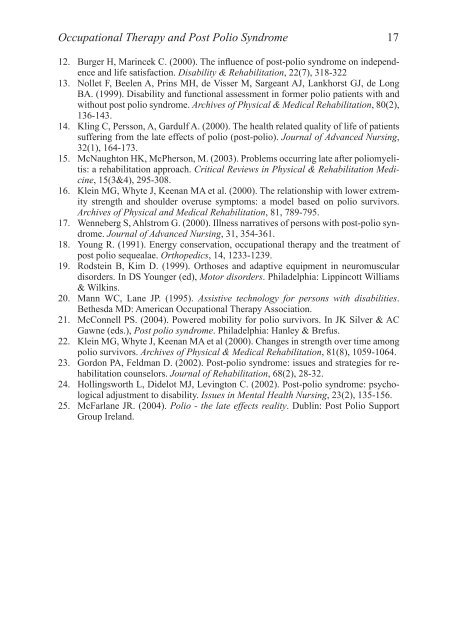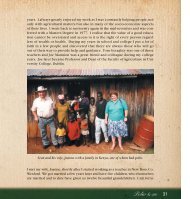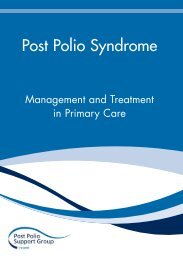Post Polio Syndrome - Management & Treatment in Primary
Post Polio Syndrome - Management & Treatment in Primary
Post Polio Syndrome - Management & Treatment in Primary
Create successful ePaper yourself
Turn your PDF publications into a flip-book with our unique Google optimized e-Paper software.
Occupational Therapy and <strong>Post</strong> <strong>Polio</strong> <strong>Syndrome</strong> 17<br />
12. Burger H, Mar<strong>in</strong>cek C. (2000). The <strong>in</strong>fluence of post-polio syndrome on <strong>in</strong>dependence<br />
and life satisfaction. Disability & Rehabilitation, 22(7), 318-322<br />
13. Nollet F, Beelen A, Pr<strong>in</strong>s MH, de Visser M, Sargeant AJ, Lankhorst GJ, de Long<br />
BA. (1999). Disability and functional assessment <strong>in</strong> former polio patients with and<br />
without post polio syndrome. Archives of Physical & Medical Rehabilitation, 80(2),<br />
136-143.<br />
14. Kl<strong>in</strong>g C, Persson, A, Gardulf A. (2000). The health related quality of life of patients<br />
suffer<strong>in</strong>g from the late effects of polio (post-polio). Journal of Advanced Nurs<strong>in</strong>g,<br />
32(1), 164-173.<br />
15. McNaughton HK, McPherson, M. (2003). Problems occurr<strong>in</strong>g late after poliomyelitis:<br />
a rehabilitation approach. Critical Reviews <strong>in</strong> Physical & Rehabilitation Medic<strong>in</strong>e,<br />
15(3&4), 295-308.<br />
16. Kle<strong>in</strong> MG, Whyte J, Keenan MA et al. (2000). The relationship with lower extremity<br />
strength and shoulder overuse symptoms: a model based on polio survivors.<br />
Archives of Physical and Medical Rehabilitation, 81, 789-795.<br />
17. Wenneberg S, Ahlstrom G. (2000). Illness narratives of persons with post-polio syndrome.<br />
Journal of Advanced Nurs<strong>in</strong>g, 31, 354-361.<br />
18. Young R. (1991). Energy conservation, occupational therapy and the treatment of<br />
post polio sequealae. Orthopedics, 14, 1233-1239.<br />
19. Rodste<strong>in</strong> B, Kim D. (1999). Orthoses and adaptive equipment <strong>in</strong> neuromuscular<br />
disorders. In DS Younger (ed), Motor disorders. Philadelphia: Lipp<strong>in</strong>cott Williams<br />
& Wilk<strong>in</strong>s.<br />
20. Mann WC, Lane JP. (1995). Assistive technology for persons with disabilities.<br />
Bethesda MD: American Occupational Therapy Association.<br />
21. McConnell PS. (2004). Powered mobility for polio survivors. In JK Silver & AC<br />
Gawne (eds.), <strong>Post</strong> polio syndrome. Philadelphia: Hanley & Brefus.<br />
22. Kle<strong>in</strong> MG, Whyte J, Keenan MA et al (2000). Changes <strong>in</strong> strength over time among<br />
polio survivors. Archives of Physical & Medical Rehabilitation, 81(8), 1059-1064.<br />
23. Gordon PA, Feldman D. (2002). <strong>Post</strong>-polio syndrome: issues and strategies for rehabilitation<br />
counselors. Journal of Rehabilitation, 68(2), 28-32.<br />
24. Holl<strong>in</strong>gsworth L, Didelot MJ, Lev<strong>in</strong>gton C. (2002). <strong>Post</strong>-polio syndrome: psychological<br />
adjustment to disability. Issues <strong>in</strong> Mental Health Nurs<strong>in</strong>g, 23(2), 135-156.<br />
25. McFarlane JR. (2004). <strong>Polio</strong> - the late effects reality. Dubl<strong>in</strong>: <strong>Post</strong> <strong>Polio</strong> Support<br />
Group Ireland.<br />
PPS Mngt and Treat.<strong>in</strong>db 17 02/07/2007 16:07:50





